Articles
- Page Path
- HOME > J Korean Acad Nurs > Volume 38(4); 2008 > Article
-
Original Article
- Impact of Psychological Factors on Marital Satisfaction and Divorce Proneness in Clinical Couples
- Seong Sook Kong
-
Journal of Korean Academy of Nursing 2008;38(4):550-560.
DOI: https://doi.org/10.4040/jkan.2008.38.4.550
Published online: August 31, 2008
Associate Professor, Department of Nursing, Soonchunhyang University, Cheonan, Korea.
- Address reprint requests to: Kong, Seong Sook. Department of Nursing, Soonchunhyang University, 336-1 Ssangyong-dong, Cheonan 330-090, Korea. Tel: 82-41-570-2488, Fax: 82-41-575-9347, kongsun@sch.ac.kr
Copyright © 2008 Korean Society of Nursing Science
Figure & Data
REFERENCES
Citations

- Social support and symptom severity among patients with obsessive-compulsive disorder or panic disorder with agoraphobia: A systematic review
Véronique Palardy, Ghassan El-Baalbaki, Catherine Fredette, Elias Rizkallah, Stéphane Guay
Europe’s Journal of Psychology.2018; 14(1): 254. CrossRef - Success Factors for Marital Satisfaction of Women in South Korea: Focusing on Interaction Factors
Eun-Ju LEE, Euna PARK
JOURNAL OF FISHRIES AND MARINE SCIENCES EDUCATION.2018; 30(3): 1051. CrossRef - Variables Influencing Martial Satisfaction of Newly Married Men and Women
Eun-Joo Jeon, Deuk-Sung Kim
Journal of Korean Home Management Association.2013; 31(1): 73. CrossRef - Relationships between Myers-Briggs Type Indicator (MBTI) Psychological Type and Marital Satisfaction, Divorce Proneness, Positive Affect, and Conflict Regulation in Clinic Couples
Seong Sook Kong
Journal of Korean Academy of Nursing.2010; 40(3): 336. CrossRef
Demographic Characteristics of the Subjects (N=57)
Demographic Characteristics and Major Variables of the Couples (N=57)
Major Variables of the Couples according to Cutoff Scores (N=57)
*N=56 (one uncompleted questionnaire for wife's MOCI was excluded); **This frequency is calculated by counting the number of participants who corresponded to at least one subscale among 10 subscales of MMPI.
Correlations among Marital Satisfaction, Divorce Proneness, Depression, Obsessive-Compulsion and MMPI subscales in Couples
D=depression; OC=obsessive-compulsion; MS=marital satisfaction; DP=divorce proneness.
*p<.05; **p<.01; ***p<.001.
Correlations among Marital Satisfaction, Divorce Proneness, and Psychological Factors in Couples
D=depression; OC=obsessive-compulsion; MS=marital satisfaction; DP=divorce proneness.
*p<.05; **p<.01; ***p<.001.
†This is made with dummy variable (correspondents with ≤30 or 70≤ at least one subscale among 10 subscales of MMPI, 0; correspondents with 31-69 in all 10 subscales of MMPI, 1).
Stepwise Multiple Regression for Marital Satisfaction and Divorce Proneness
MA=hypomania; SI=social introversion.
*N=56 (one uncompleted questionnaire for wife's MOCI was excluded); **This frequency is calculated by counting the number of participants who corresponded to at least one subscale among 10 subscales of MMPI.
D=depression; OC=obsessive-compulsion; MS=marital satisfaction; DP=divorce proneness. *p<.05; **p<.01; ***p<.001.
D=depression; OC=obsessive-compulsion; MS=marital satisfaction; DP=divorce proneness. *p<.05; **p<.01; ***p<.001. †This is made with dummy variable (correspondents with ≤30 or 70≤ at least one subscale among 10 subscales of MMPI, 0; correspondents with 31-69 in all 10 subscales of MMPI, 1).
MA=hypomania; SI=social introversion.
 KSNS
KSNS
 E-SUBMISSION
E-SUBMISSION
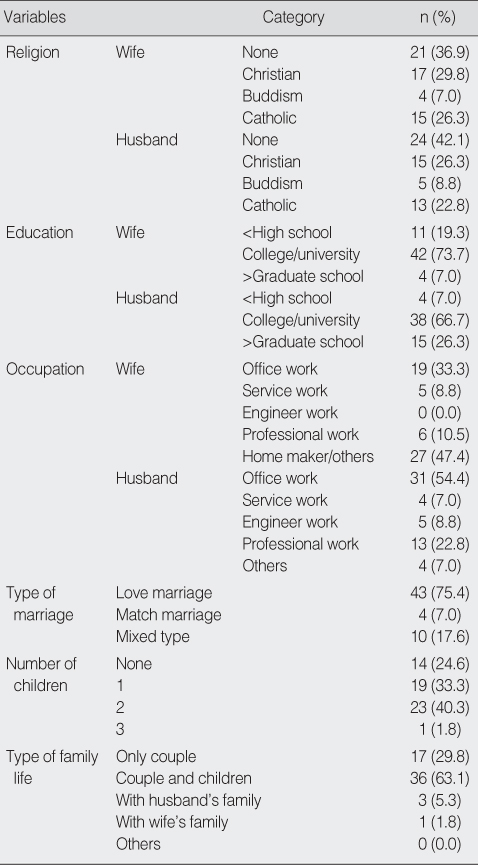
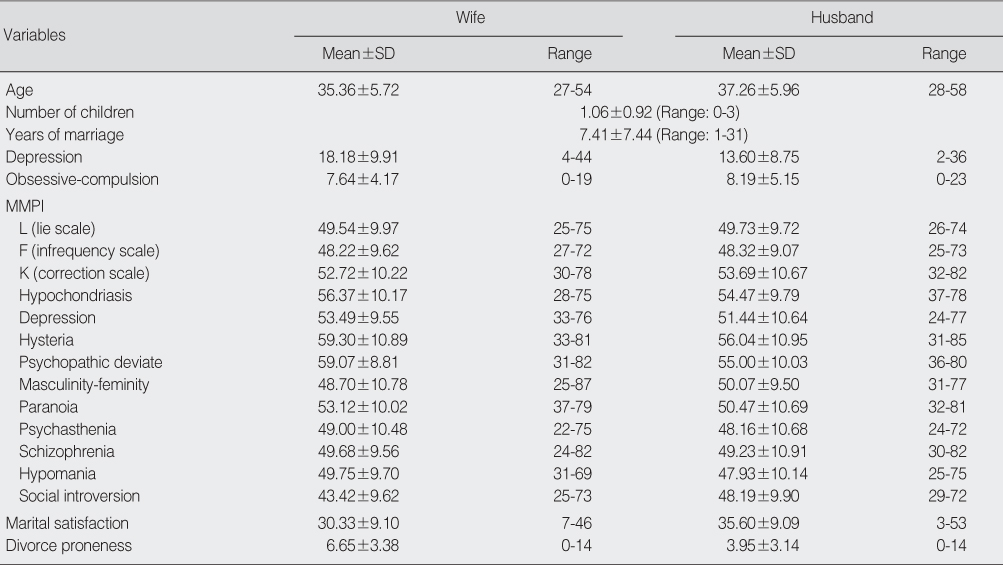
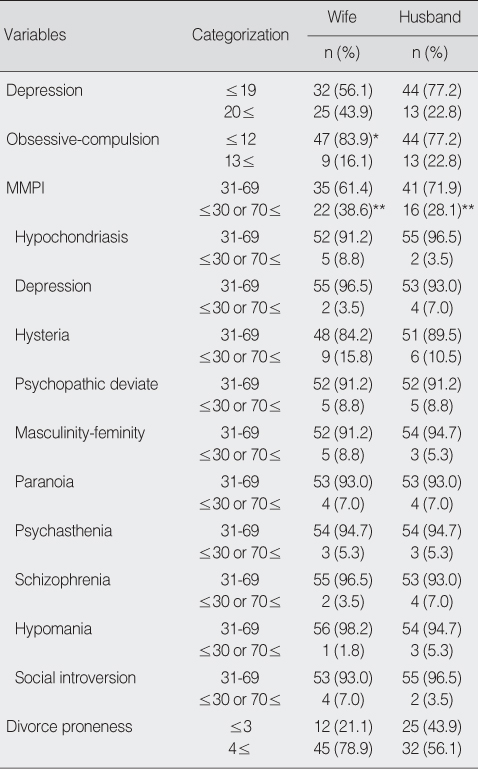
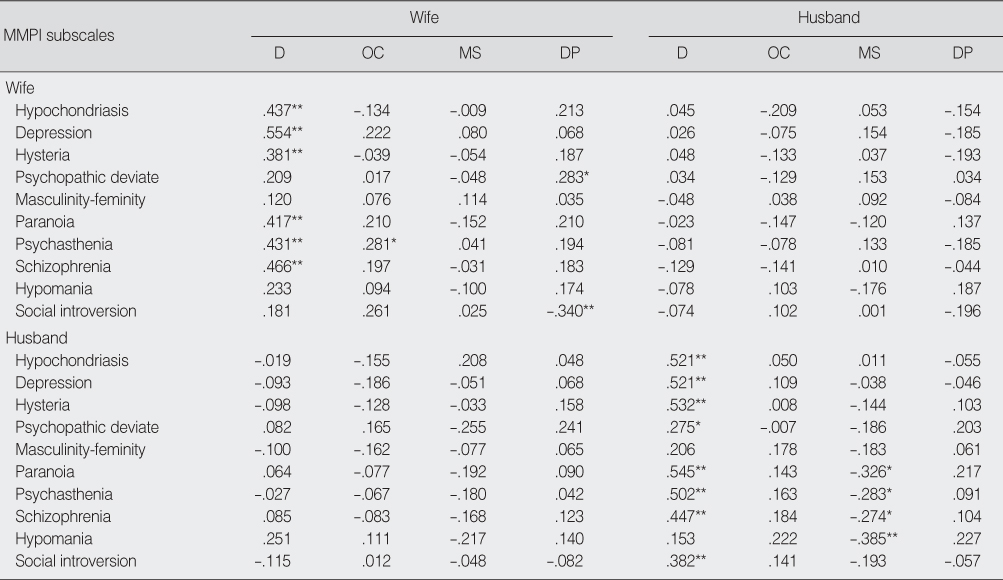
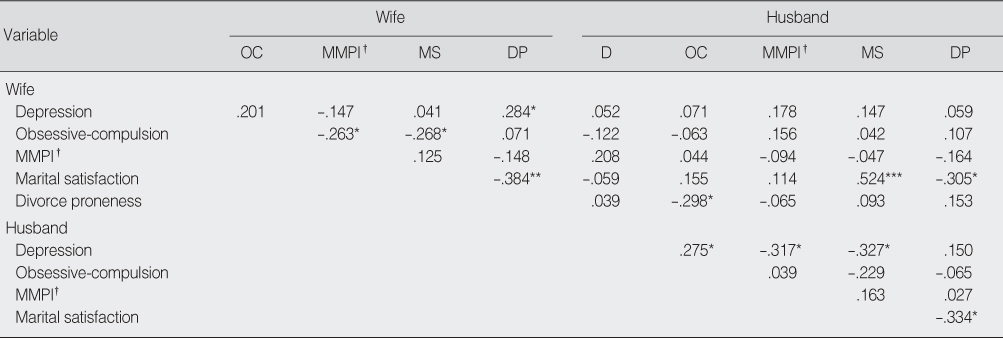

 Cite
Cite

